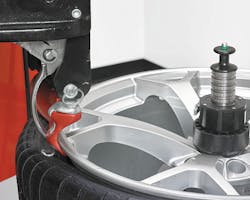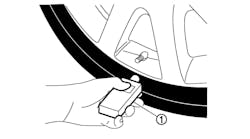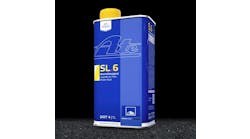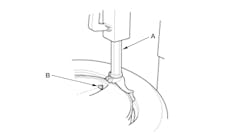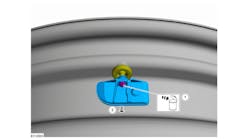Servicing Run-Flat Tires: Stiffer Sidewalls are Just One Issue of Concern
What does a dealer need to know to service a run-flat tire versus a non-run-flat tire? That is the question we asked the experts on your behalf.
And who better to ask first than the mounting and balancing equipment manufacturers? Pete Liebetreu, senior product manager for Hunter Engineering Co., had both a short and long answer.
“The short answer? A lot!” he said. “Run-flats are much more than ‘just a harder tire.’ Just like non-run-flat tires can vary widely, so can run-flats. As a general rule they have stiffer sidewalls than conventional tires, so they are more difficult to mount and demount.
“This is especially true for top bead demounting and mounting. You almost always need, at minimum, a single press arm or, even better, multiple press arms to service them professionally.”
Liebetreu said size matters when it comes to servicing run-flat tires. Smaller diameter run-flats (i.e., 17 – and 18-inch sizes) are often more difficult to handle then their larger counterparts.
“Tall (high aspect ratio) sidewalls are also usually harder to mount than low profile run-flats because the taller the sidewall, the stiffer the construction.”
Tire dealers should also keep in mind that not all run-flats are equally stiff. “It depends on the specific design for the specific application,” said Liebetreu. “The OEM usually determines the stiffness that is acceptable based on the desired ride and handling goals.”
The stiffness in a run-flat tire compared to a conventional tire plays an important part in the vehicle’s overall suspension performance. So substituting non-run-flats or run-flats with a different stiffness characteristic can have ride quality implications that a dealer might not see when they are replacing the original run-flats, he said.
“Because run-flats are already so stiff, those vehicles also can be more sensitive to road force variations. When balanced, they should also be road force checked and corrected as well.”
As part of its Basic Automotive Tire Service Training Series, the Tire Industry Association has a training module detailing how to demount and mount run-flat tires.
What the tire makers say
Tire manufacturers say the differences between run-flat tires and conventional tires are minimal yet prominent.
“Servicing run-flat product in regards to the normal protocol for inflation checks, rotation and visual inspection is the same as that for a traditional tire,” said Gerardo Andrade, senior manager of market quality for Pirelli Tire North America Inc. “One difference that dealers and service technicians might notice is that vehicles using a run-flat product must be equipped with TPMS or a similar approved monitoring system which should be taken into account when servicing the tire.”
Bob Abram, senior manager of product planning for Yokohama Tire Corp., said due to the unique construction of a zero-pressure tire — and the tire pressure monitoring system (TPMS) with which it is associated — more care should be taken when dismounting and/or mounting.
According to Yokohama’s ZPS (Zero Pressure System) Technical Service Guidelines, run-flat tires should never be mixed with tires that do not have run-flat technology. In addition, “Never mix run-flat tires of different brands or technology.”Juan Britos, senior technical services specialist for Hankook Tire America Corp., said the only major difference between servicing regular and run-flat tires is the type of mounting equipment needed. “Run-flat tires require multi-armed mounting equipment to support the tire. Other than that, the two styles are serviced in a similar manner.”
Goodyear Tire & Rubber Co.’s Goodyear (ROF, or Run On Flat) and Dunlop (SST, or Self-Supporting Technology) run-flat tires feature a patented sidewall construction that allows continued driving on a flat tire for up to 50 miles at 50 mph in normal conditions. However, the tire may have to be replaced if driven to these limits, said Bob Toth, director of industry relations.
“Goodyear run-flat tires are mounted on wheels using the same technique used to mount non-run-flat designs. Because run-flat tires have heavier, more reinforced sidewalls, they are sometimes more difficult to position on a wheel for mounting.
“Many tire equipment manufacturers have developed special machine designs, attachments and training that make mounting and dismounting run-flat tires easier. This equipment and training can reduce the possibility of damaged beads and scratched wheels.
“To properly seat the beads on Goodyear run-flat tires, more than 40 psi may be required, and a safety cage and clip-on extension air hose must be used,” he added.
“Dealers should become familiar with the run-flat tire category, as they are likely to encounter customers whose vehicles are equipped with this tire type,” said Robert Saul, director of consumer product strategy for Bridgestone Americas Tire Operations LLC.
“Run-flat tires are no longer only reserved for exotic sports cars. Today, there are minivans such as the Toyota Sienna and popular coupes like the Mini that are equipped with run-flat tires from the factory.”
In the early days of run-flat technology, dealers had to take special care when mounting and dismounting run-flat tires to avoid damaging the then-rare TPMS because they were not familiar with it.
“Since 2008, most cars and light trucks come originally equipped with TPMS, so this isn’t as much of a concern today,” said Saul. “Stiff sidewalls and ultra-low profile tire sizes also were a hallmark of early run-flat applications, and these tires could be difficult to mount and dismount without newer tire changing equipment.
“With larger wheel sizes and lower aspect ratios becoming popular across the industry, it’s important for dealers to have the equipment needed to service run-flat tires on today’s vehicles.”
Chris Davis, technical product service manager for Continental Tire the Americas LLC said more vehicle manufacturers are turning to run-flat tires as a way to cut the space requirements and weight in the vehicles “in attempts to improve fuel efficiency as well as customer safety air loss occur on the highway.
“Tires should be replaced following vehicle manufacturer’s recommendations,” he said. “Customers may want to go to a standard tire due to improved ride or cost concerns. Advise the customer of the vehicle recommendation utilizing a run-flat tire.
“Often these vehicles are recommended to replace with an OEM marked tire, such as a Star for BMW or MO for Mercedes Benz, for example. Deviating from these markings can affect the vehicle performance as well as warranties or leasing contracts.
“If the consumer chooses to make the switch from run flats to standard tires, replace all tires. The differences in performance characteristics between the two tire constructions can make the vehicle not handle as expected to result in a dissatisfied customer and possible instability of the vehicle.”
On the flip side, some customers may want to replace standard tires with run-flat tires. “In this case, the dealer should verify the TPMS in the vehicle is fully functional, and the rim is approved for the tire being installed,” said Davis. “Customers may not notice the gradual air pressure drop of a slow leak visually due to the supporting structure of the tire. Run-flat tires should not be installed on vehicles without TPMS.” ■
Now you know why the service needs of run-flat tires are unique. In part two of our two-part series, we will definitively answer the question, “Can run-flat tires be repaired?”
Mounting and demounting: Focus on these 3 run-flat tire concerns
Don Vanderheyden, director of marketing for Hennessy Industries Inc., says there are three primary considerations when servicing run-flat tires:
1. Handling the tire\wheel assembly. “Because run flat tire/wheel assemblies are highly valued, highly priced commodities, service technicians want to take the time to be careful to not damage the rims. If not, damage can easily occur, which means money out of the shop’s pocket.”
2. Clamping the wheel. “We always recommend external clamping, as this not only holds the wheel better, but also avoids any damage that internal clamping can do to the rim.”
3. Removing & installing the tire. “When mounting or demounting, specific cautionary actions need to be taken to ensure every step of the process is protecting the customer’s tires and wheels. From handling TPMS sensors properly, using enough lube, to using the necessary helper devices that make a stiff side wall of a tire that much easier to change, every step counts.”
